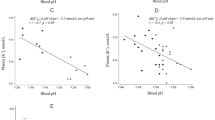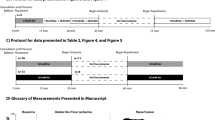Summary
Intracellular sodium activity (aNa i), intracellular pH (pHi) and membrane potential were directly and continuously measured in sheep cardiac Purkinje fibers using neutral carrier liquid membrane ionselective microelectrodes. Changing the superfusing medium from normal Tyrode's solution to the cardioplegic solution “HTK” according to Bretschneider (6) a depolarization from −73.7±7.2 mV to −55.0±9.5 mV (n=25), a decrease of aNa i from 9.1±1.9 mM to 4.0±1.4 mM (n=25) and an intracellular acidification from pHi 7.18±0.06 to pHi 7.01±0.06 (n=11, x±S.D.) occurred at 35°C. The decrease of intracellular sodium activity was not effected by replacement of K, Mg, or histidine by mannitol in the cardioplegic solution. Addition of 4 mM Ca somewhat enhanced aNa i decline. Inhibition of the sodium pump with the cardiac steroid dihydroouabain (10−4 M) lowered the effect of “HTK” on intracellular sodium by approximately 35% (n=5). Sodium decline was also sensitive to equilibration temperature, giving a Q10 of 1.54 for the initial decrease velocity (temperature range 20 to 35°C), which is less than that found by other investigators for pure sodium pump activity. It is suggested that although the electrochemical sodium gradient remains inward throughout, sodium may leave myocardial cells on induction of Bretschneider's cardioplegia because of a reduction of inward fluxes by simultaneously increasing sodium pump activity, thus increasing Na efflux. Na/Ca exchange is assumed to be of minor importance and the Na/H exchange may be involved. With respect to the clinical application of the low Na and nominally Ca-free cardioplegic solution “HTK” lowering of intracellular sodium activity is interpreted as a factor minimizing the risk of a “calcium paradox” on reperfusion with Ca at serum levels, as well as a possible mechanism preventing early development of cellular edema.
Similar content being viewed by others
References
Ammann D (1986) Ion-selective microelectrodes. Principles, design and application. Springer, Berlin Heidelberg New York
Bers DM, Ellis D (1982) Intracellular calcium and sodium activity in sheep heart Purkinje fibres: effect of external sodium and intracellular pH. Pflügers Arch 393:171–178
Bers DM, Allen LH, Kim Y (1986) Calcium binding to cardiac sarcolemmal vesicles: potential role as a modifier of contraction. Am J Physiol 251:C861-C871
Boink ABTJ, Ruigrok TJC, de Moes D, Maas AHJ, Zimmermann ANE (1980) The effect of hypothermia on the occurrence of the calcium paradox. Pflügers Arch 385:105–109
Bretschneider HJ (1964) Überlebenszeit und Wiederbelebungszeit des Herzens bei Normo- und Hypothermie. Verh Dtsch Ges Kreisl-Forsch 30:11–34
Bretschneider HJ, Gebhard MM, Preusse HJ (1981) Reviewing the pros and cons of myocardial preservation within cardiac surgery. In: Longmore DB (ed) Towards safer cardiac surgery. MTP Press Ltd., Lancaster, pp 21–53
Chapman RA, Coray A, McGuigan JAS (1983) Sodium/calcium exchange in mammalian ventricular muscle: a study with sodium-sensitive micro-electrodes. J Physiol. 343:253–276
Chapman RA, Rodrigo GC, Tunstall J, Yates RJ, Busselen P (1984) Calcium paradox of the heart: a role for intracellular sodium ions. Am J Physiol 247:H874-H879
Chapman RA (1986) Sodium/calcium exchange and intracellular calcium buffering in ferret myocardium: an ion-sensitive micro-electrode study. J Physiol 373:163–179
Chapman RA, Fozzard HA, Friedlander IR, January CT (1986) Effect of Ca2+/Mg2+ removal on aNa i, ak i and tension in cardiac Purkinje fibres. Am J Physiol 251:C920-C927
Daly MJ, Elz JS, Nayler WG (1987) Contracture and the calcium paradox in the rat heart. Circ Res 61:560–569
Deitmer JW, Ellis D (1978) Changes in the intracellular sodium activity of sheep heart Purkinje fibres produced by calcium and other divalent cations. J Physiol 277:437–453
Deitmer JW, Ellis D (1978) The intracellular sodium activity of cardiac Purkinje fibres during inhibition and re-activation of the Na−K pump. J Physiol 284:241–259
Deitmer JW, Ellis D (1980) Interactions between the regulation of the intracellular pH and sodium activity of sheep cardiac Purkinje fibres. J Physiol 304:471–488
Ellis D, Thomas RC (1976) Direct measurement of the intracellular pH of mammalian cardiac muscle. J Physiol 262:755–771
Ellis D (1977) The effects of external cations and ouabain on the intracellular sodium activity of sheep heart Purkinje fibres. J Physiol 273:211–240
Ellis D, MacLeod KT (1985) Sodium-dependent control of intracellular pH in Purkinje fibres of sheep heart. J Physiol 359:81–105
Frelin C, Vigne P, Lazdunski M (1984) The role of the Na+/H+ exchange system in cardiac cells in relation to the control of the internal Na+ concentration. J Biol Chem 259:8880–8885
Garlick PB, Radda GK, Seeley PJ (1979) Studies of acidosis in the ischemic heart by phosphorus nuclear magnetic resonance. Biochem J 184:547–554
Gebhard MM, Bretschneider HJ, Mezger VA, Preusse CJ, Spieckermann PG (1981) Principles to avoid the calcium paradox in myocardial protection. In: Isselhard W (ed) Myocardial Protection for Cardiac Surgery. Pharmazeutische Verlagsgesellschaft, München, pp 74–82
Gebhard MM, Bretschneider HJ, Gersing E, Preusse CJ, Schnabel PhA, Ulbricht LJ (1983) Calcium-free cardioplegia—pro. Eur Heart J 4 (Suppl H):151–160
Gebhard MM, Bretschneider HJ, Preusse CJ (1984) Cardioplegia: principles and problems. In: Sperelakis N (ed) Physiology and Pathophysiology of the Heart. Martinus Nijhoff Publishing, Boston The Hague, pp 605–616
Glitsch HG, Kampmann W, Pusch H (1981) Activation of active Na transport in sheep Purkinje fibres by external K or Rb ions. Pflügers Arch 391:28–34
Glitsch HG, Pusch H (1984) On the temperature dependence of the Na pump in sheep Purkinje fibres. Pflügers Arch 402:109–115
Jennings RB (1975) Cell volume regulation in acute myocardial ischemic injury. Acta Med Scand Suppl 587:83–92
Jynge P, Hearse DJ, Braimbridge MV (1977) Myocardial protection during ischemic cardiac arrest: a possible hazard with calcium free cardioplegic infusates. J Thorac Cardiovasc Surg 73:848–855
Krohn E, Stinner B, Gebhard MM, Fleckenstein M, Bretschneider HJ (1988) The effect of sodium pump inhibition on intracellular sodium activity on induction of St. Thomas' and Bretschneider's type of cardioplegia. Pflügers Arch 411, R33
Levitsky S (1983) Myocardial protection in cardiac surgery—possibilities and limitations. In: Refsum H, Jynge P, Mjös OD (eds) Myocardial ischemia and protection. Churchill Livingstone, Edinburgh, pp 64–78
Lüttgau HC, Niedergerke R (1958) The antagonism between Ca and Na ions on the frog's heart. J Physiol 143:486–505
Macknight ADC, Leaf A (1977) Regulation of cellular volume. Physiol Rev 57:510–573
O'Doherty J, Garcia-Diaz JF, Armstrong WMcD (1979) Sodium-selective liquid ion-exchanger microelectrodes for intracellular measurements. Science 203:1349–1351
Orellano LE, Grebe D, Bretschneider HJ (1967) Fortlaufende Messung der Kalium- und Natriumverluste des Myokards während eines Herzstillstandes durch Koronarperfusion mit natriumarmen, calciumfrcien, procainhaltigen, sauerstoffgesättigten kardioplegischen Lösungen. Arch Kreisl-Forsch 53:264–307
Preusse CJ, Gebhard MM, Bretschneider HJ (1981) Myocardial “equilibration processes” and myocardial energy turnover during initiation of artificial cardiac arrest with cardioplegic solution-reasons for a sufficiently long cardioplegic perfusion. Thorac Cardiovasc Surgeon 29:71–76
Preusse CJ, Gebhard MM, Bretschneider HJ (1982) Interstitial pH value in the myocardium as indicator of ischemic stress of cardioplegically arrested hearts. Basic Res Cardiol 77:372–387
Ruano-Arroyo G, Gerstenblith G, Lakatta EG (1984) ‘Calcium paradox’ in the heart is modulated by cell sodium during the calcium-free period. J Mol Cell Cardiol 16:783–793
Ruigrock TJC, Burgersdijk FJA, Zimmermann ANE (1975) The calcium paradox: a reaffirmation. Eur J Cardiol 3:59–63
Schlue WR, Thomas RC (1985) A dual mechanism for intracellular pH regulation by Leech neurones. J Physiol 364:327–338
Schnabel PhA, Gebhard MM, Pomykaj Th, Schmiedl A, Preusse CJ, Richter J, Bretschneider HJ (1987) Myocardial protection: left ventricular ultrastructure after different forms of cardiac arrest. Thorac cardiovasc Surgeon 35:148–156
Stinner B, Gebhard MM, Krohn E, Schumacher Th, Bretschneider HJ (1987) The influence of cardioplegic solutions on intracellular pH and sodium activity in mammalian heart muscle. Z Kardiol 76 (Suppl I):P79
Tunstall J, Busselen P, Rodrigo GC, Chapman RA (1986) Pathways for the movements of ions during calcium-free perfusion and the induction of the calcium paradox. J Mol Cell Cardiol 18:241–254
Author information
Authors and Affiliations
Additional information
Supported by the DFG, SFB 330 “Organprotektion”.
Part of this work has already been published in abstract form (Pflüg. Arch. 1987: 408, R11) and comprises unpublished results of E. Krohn's thesis.
The technical assistance of Mrs. U. Markmann and Mrs. E. Neumeyer is gratefully acknowledged.
Rights and permissions
About this article
Cite this article
Stinner, B., Krohn, E., Gebhard, M.M. et al. Intracellular sodium activity and Bretschneider's cardioplegia: Continuous measurement by ionselective microelectrodes at initial equilibration. Basic Res Cardiol 84, 197–207 (1989). https://doi.org/10.1007/BF01907929
Received:
Issue Date:
DOI: https://doi.org/10.1007/BF01907929




